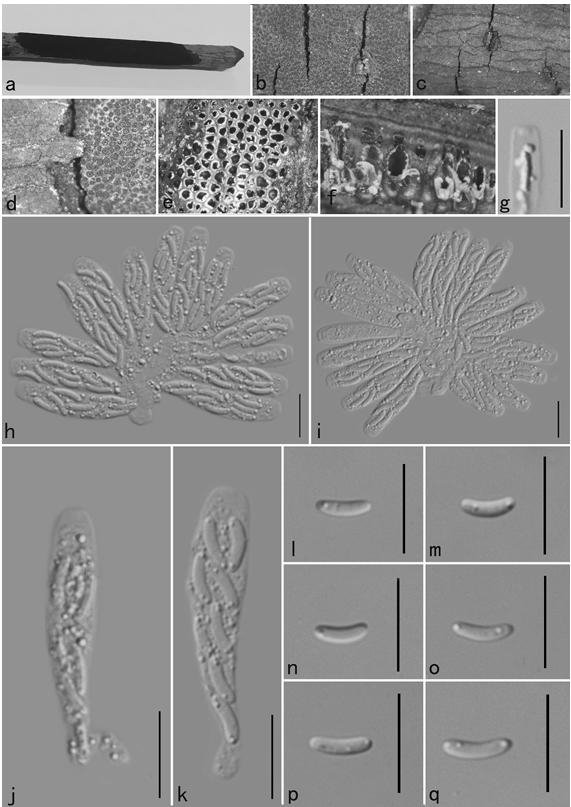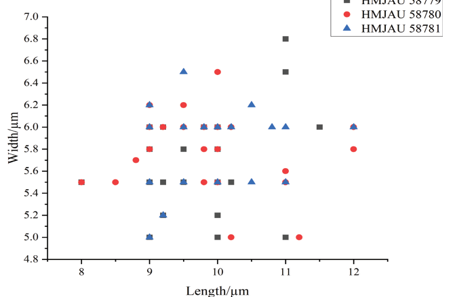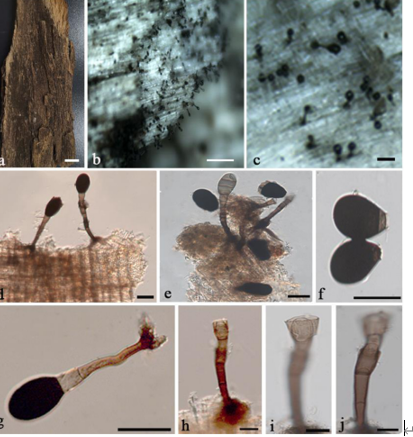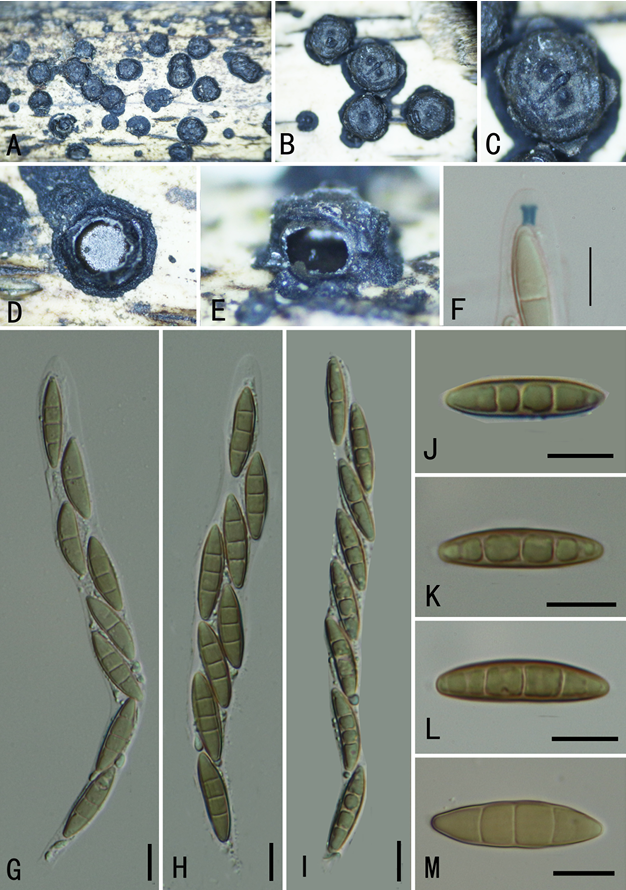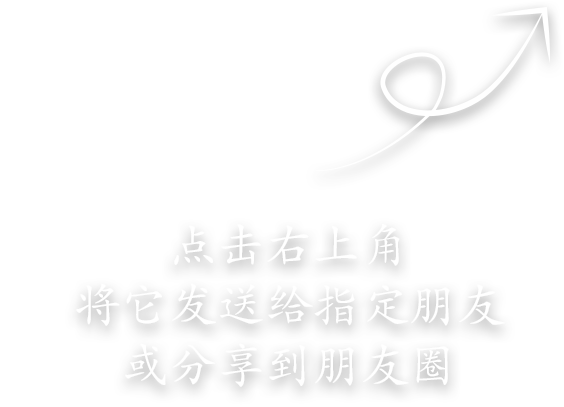Tomentella citrinocystidiata H.S. Yuan & Y.C. Dai 2020
Index Fungorum number: IF555692; Facesoffungi number: FoF 05610
Holotype: CHINA, Liaoning Province, Huanren County, Laotudingzi Nature Reserve, on rotten angiosperm wood debris, 21 October 2015, Yuan 10680 (IFP 019331, holotype); Qingyuan County, Experimental Station of Forest Ecology, on rotten angiosperm wood debris, 22 October 2015, Yuan 10743 (IFP 019332).
Morphological description
Basidiocarps annual, resupinate, separable from the substrate, pelliculose, without odour or taste when fresh, 0.1–0.2 mm thick, continuous. Hymenophoral surface smooth, dark brown (6F5–7) when dry. Sterile margin often indeterminate, byssoid, concolorous with subiculum, more or less yellowish brown. Subiculum mostly yellowish brown, paler than hymenophore. Rhizomorphs present in subiculum and margins, 15–30 μm diam; rhizomorphic surface more or less smooth; hyphae in rhizomorph monomitic, differentiated, of type C, compactly arranged; hyphae in center of rhizomorph usually clamped, rarely simple septate, thickwalled, unbranched, 3–3.5 μm diam; hyphae at outer part of rhizomorph clamped, thick-walled, unbranched, 2–2.5 μm diam; all the hyphae pale orange in KOH, cyanophilous, inamyloid. Subicular hyphae monomitic; generative hyphae mostly clamped and rarely simple septate, thick-walled, rarely branched, 3–5 μm diam, occasionally collapsed and encrusted, pale orange in KOH, cyanophilous, inamyloid. Subhymenial hyphae thin- to slightly thick-walled, clamped, frequently branched, 3–5 μm diam; hyphal cells short and inflated, pale orange in KOH, cyanophilous, inamyloid. Cystidia arising from subhymenial or from subicular hyphae, 60–80 μm long, 5–7.5 μm diam at base and 10–15 μm diam at apex, capitate, embedded, without encrustation, pale orange in KOH. Basidia 30–70 μm long and 5–10 μm diam at apex, 5–7 μm at base, with a clamp connection at base, clavate, stalked, sinuous, without transverse septa, pale orange in KOH, yellowish brown in distilled water, 4-sterigmate; sterigmata 4–7 μm long and 1–2 μm diam at base. Basidiospores thick-walled, (7–)7.4–8.5(–9) × (6.5–)7.1– 7.9(–8.5) μm, L = 7.92 μm, W = 7.41 μm, Q = 1.07–1.12 (n = 60/2), irregular globose or lobed in frontal view and ellipsoid in lateral view, echinulate to aculeate, pale brown in KOH, pale brown in distilled water, cyanophilous, inamyloid; echinuli usually isolated, sometimes grouped in 2 or more, up to 1.5 μm long.
Habitat: On rotten angiosperm wood debris.
Distribution: In China.
GenBank Accession: ITS: KY686246, KY686247; LSU: MK446348, MK446349.
Notes: Tomentella capitata, T. cystidiata and T. citrinocystidiata share similar morphological and anatomical characteristics: brown to dark brown, continuous basidiocarps separable from the substrate, a smooth hymenophore, a byssoid sterile margin, the presence of rhizomorphs and capitate cystidia, thin- to thick-walled subhymenial hyphae and basidiospores of approximately the same shape and size. However, T. capitata is differentiated from T. citrinocystidiata by having a granulose or farinose hymenophore and the presence of cystidia from the rhizomorphic surface (Yorou et al. 2007); T. cystidiata differs from T. citrinocystidiata by having arachnoid basidiocarps, a uniform subhymenial hyphae, no encrustated subicular hyphae, and basidiospores bearing long echinuli.
Reference: Hai‑Sheng Yuan1,2· Xu Lu1,2 · Yu‑Cheng Dai3 ·
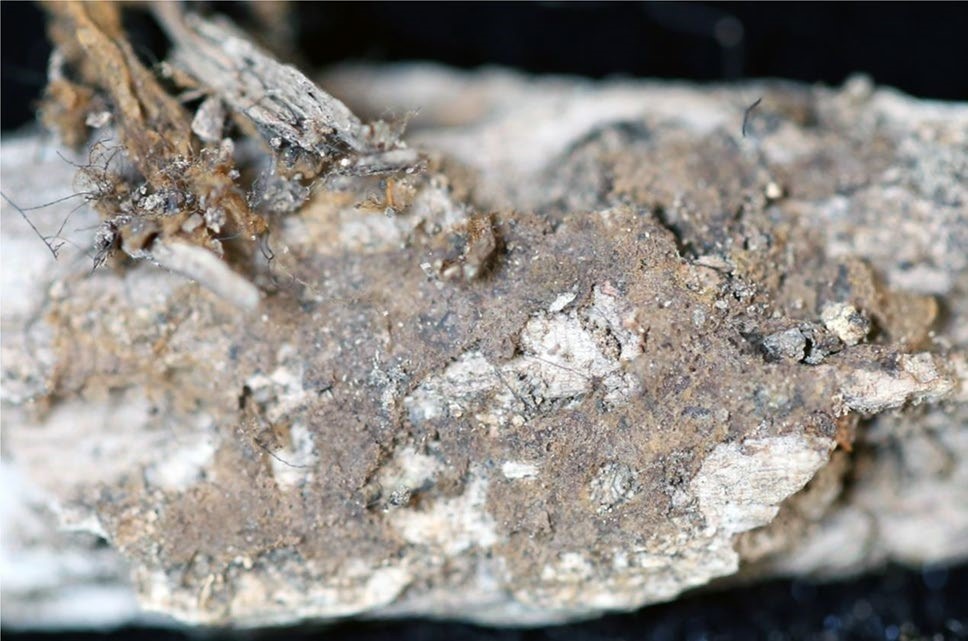
A basidiocarp of Tomentella citrinocystidiata (IFP 019331, holotype)


